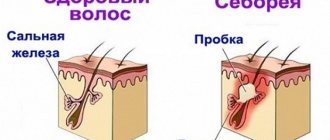Dermatovenerologist
Khasanova
Alina Rashidovna
9 years experience
Make an appointment
Redness of the skin in a certain area of the body, caused by the expansion of the vascular network and increased blood flow into these vessels, is called erythema. Unlike the manifestations of hemorrhage, when pressing on the affected area of the skin, the redness disappears. Skin reactions are caused by various factors - adverse external influences, inflammatory processes, pathological changes. Red spots appearing on the skin may have clear or blurred boundaries, accompanied by swelling, peeling, itching, etc.
Types of pathology
Erythema is classified according to the type of vessels affected:
- active - occurring with a sharp expansion of the lumen of arterial vessels, accompanied by an acute inflammatory process, with bright redness of the skin, increased temperature, swelling and soreness of the skin;
- passive - formed when blood stagnates in the venous vessels during their expansion, accompanied by the appearance of bluish-red or burgundy spots, mainly accompanying inflammation with a chronic course.
Each variety is caused by different causative factors and requires a separate therapeutic approach.
Based on etiology, the following types of erythema are distinguished:
- non-infectious - which are the physiological reaction of the body to external or internal irritants (solar ultraviolet radiation, critically high or low temperature, allergens, etc.);
- infectious - caused by the penetration of infection into the skin capillaries through the surface of the epidermis, from the systemic bloodstream or through the mucous membrane.
Non-infectious manifestations usually do not require special treatment, as they go away on their own after the action of the provoking factor ceases. Infectious reactions are expressed in an inflammatory process that occurs in an acute or chronic form and is accompanied by certain symptoms.
Causes
Before starting treatment for erythema in children, this disease should be accurately diagnosed and the causative agent identified. The thing is that this anomaly is often confused with other skin diseases - rubella, urticaria, dermatitis, etc. But this pathology requires certain therapy, so a correct diagnosis is extremely important.
The main cause of erythema in children, or rather redness of the skin, is dilation of the capillaries. But this is achieved by other factors that affect the child’s body both externally and internally. Due to the structural features of the dermis, this disease is not uncommon in children. The thing is that their blood vessels are located quite close to the surface, to the epidermis itself. And any provoking factor causes rapid expansion of small vessels. This is what leads to redness of the skin.
A large number of erythemas have completely normal, natural and safe causes. Redness on the skin in children may appear as a reaction to touch, including massage. At elevated air temperatures (in a bathhouse or sauna), capillaries can also respond - expand. Erythema appears in a child during active games or sports. The explanation is quite simple - the blood supply becomes more intense, and under blood pressure the capillaries become larger.
But the pathological causes of this disease are determined by:
- infectious diseases that the child had or has;
- chemical burns;
- thermal burns;
- allergic reactions;
- post-traumatic changes that are observed in the skin;
- diseases occurring against the background of elevated body temperature.
When should you see a doctor?
At the first symptoms of erythema in children, you should contact a highly specialized physician. Allergists treat such pathologies. They carry out an external examination, give directions for certain tests, and make a conclusion. Based on it, the diagnosis is either confirmed or refuted.
If you are looking for an experienced specialist, we recommend contacting JSC “Medicine” (clinic of academician Roitberg), located in the central district of Moscow at the address: 2nd Tverskoy-Yamskaya lane 10. Our clinic is located near the Mayakovskaya, Belorusskaya, Novoslobodskaya metro stations , Tverskaya, Chekhovskaya.
But what symptoms indicate erythema in children? Let's take a closer look.
Non-infectious manifestations
In accordance with the causes that caused them, erythema of non-infectious etiology is divided into:
- infrared - provoked by infrared radiation, the power of which was not enough for a full burn, and manifested in the form of a reddish vascular network;
- X-ray – caused by exposure to X-rays or high-frequency electromagnetic waves;
- symptomatic - appearing after contact with an allergenic agent in the form of hyperemic convex spots of irregular shape;
- idiopathic - formed under the influence of heredity as an increase in the diameter of capillaries at the junction with the vascular network, with redness of the palmar surfaces;
- cold - formed when the skin is exposed to low temperatures, manifesting itself in the form of a bluish-reddish rash with local swelling and itching;
- ultraviolet - appearing as a result of exposure to ultraviolet radiation on the skin.
In most cases, when the action of the provoking factor ceases, the redness disappears after some time. In some cases, symptomatic help is required.
What are the means to prevent fifth disease?
There is no vaccine for fifth disease. However, there are several recommendations that you, your family members and your children can follow to reduce the likelihood of infection in the family:
- Wash your hands frequently with soap and water for at least 20 seconds.
- Cover your nose and mouth when sneezing or coughing.
- Avoid touching your face, especially your nose, eyes and mouth.
- Try not to contact potentially infected people.
- If you have fifth disease, stay home and avoid contact with other people to avoid infecting them.
Infectious pathologies
Various pathogens can provoke the development of infectious inflammation of the skin - bacteria, fungi, viruses or parasites. This form is characterized by an acute course, which can turn into a chronic form. The patient needs immediate medical attention.
In its acute form, the most common erythema infectiosum in children is caused by parvovirus B19. It is characterized by the sudden onset of the disease, the characteristic signs of which are:
- rapidly rising body temperature;
- muscle pain, headache;
- the appearance of a red rash covering the face and body on the third or fourth day after the onset of the disease;
- gradual increase and closure of spots.
After some time, clinical manifestations gradually fade away until they disappear completely. If left untreated, the process can become chronic. The patient remains able to transmit the infection to healthy people for several days after recovery.
Erythema infectiosum (fifth disease)
The main clinical forms of erythema are: 1) erythema infectiosum of Rosenberg, 2) erythema infectiosum of Chamer, 3) erythema nodosum, 4) erythema multiforme exudative, 5) sudden exanthema, 6) undifferentiated erythema. Infectious erythema of Rosenberg (Erythema infectiosum Rosenberg) is characterized by an acute onset, severe fever and symptoms of general intoxication (severe headache, insomnia, myalgia and arthralgia). On the 4-6th day, a profuse spotty or maculopapular rash appears, predominantly localized on the extensor surfaces of the extremities, condensing in the area of large joints and on the buttocks, where they form continuous erythematous fields. There is no rash on the face. After 5-6 days, the exanthema disappears, leaving behind a pityriasis-like or lamellar peeling. Fever lasts 8-12 days. The liver and spleen are often enlarged. Some patients may have swelling of the joints, as well as meningeal phenomena.
infectiosum Tschamer. The incubation period lasts 9-14 days. The disease is mild. Children get sick more often. Body temperature is normal or subfebrile. From the first day of illness, a characteristic rash appears on the skin of the face, first in the form of small spots, which then merge and form a butterfly shape. Individual elements of the rash may appear on the torso and limbs. Elements of the rash turn pale, starting from the center. Exanthema persists for a long time (about 2 weeks). Sometimes elements of the rash that have almost disappeared appear again in the same place. A new appearance of the rash can be triggered by fever, overheating, and physical exertion. Some patients experience moderate inflammatory changes in the upper respiratory tract and conjunctival hyperemia. Some patients, mainly adults, experience moderate pain and swelling of the joints. Currently, the causative agent of this infection has been identified as human parvovirus (B 19). The infection often occurs inapparently (asymptomatic), since antibodies to this virus are found in 30-40% of healthy people.
Erythema nodosum is one of the manifestations of a number of infectious diseases (tularemia, rheumatism, tuberculosis, etc.). It is characterized by an increase in body temperature (if it has not already been increased due to the underlying disease), aching pain in the extremities, especially in large joints, and a characteristic exanthema. The rash appears on symmetrical areas of the legs and forearms, less often on the thighs and feet. The elements of the rash are nodes (up to 3-5 cm in diameter), dense and painful on palpation, rising above the skin level; an infiltrate can be felt deep in the skin. The color of the skin over the nodes is initially red, then becomes cyanotic and, as the infiltrate decreases, greenish-yellowish. Nodes are stored for up to 3 weeks.
Multiform (polyform) exudative erythema (Erythema exudative multiforme) is characterized by fever (39-40°C), symptoms of general intoxication (headache, weakness, arthralgia). On the 4-6th day, a profuse polymorphic rash appears, involving the torso and limbs. Sometimes there is symmetry of the rashes. The elements of the rash are spots and papules. The formation of bubbles filled with transparent contents is especially characteristic. After the blister ruptures, a red abrasion and then a brownish crust form in its place. At the site of the rash, patients note itching and burning of the skin. With a more severe version of erythema - Stevens-Johnson syndrome, in addition to skin damage, erosive and ulcerative changes occur in the mucous membrane of the mouth, nasopharynx, genitals, and anus. The disease usually lasts 1~3 weeks, and Stevens-Johnson syndrome lasts up to 6 weeks or more. Deaths have been described.
Sudden exanthema (Erythema subitum) . The incubation period lasts 3-5 days. The disease begins with an acutely rapid increase in body temperature to 38-40°C and relatively mild symptoms of general intoxication. On the 3-4th day of illness, the temperature drops to normal, and at this time an exanthema appears (or after 1-2 days), involving the face, torso and limbs. The elements of the rash are small pale pink spots (up to 5 mm in diameter), which sometimes merge and resemble the rash of measles (but not as bright) or rubella. After 2-3 days, the rash disappears, leaving behind neither peeling nor pigmentation. In the blood in the first days of the disease, neutrophilic leukocytosis is observed, and when a rash appears, leukopenia, neutropenia, and lymphocytosis are observed.
Undifferentiated erythema infectiosum (according to A.I. Ivanov) is a collective group of infectious diseases of unclear (or unspecified) etiology, characterized by fever, moderate symptoms of general intoxication and exanthema, which is not typical for any known infectious disease.
Nodular pathologists
The causative agent of erythema nodosum is usually streptococcus, and less often - some other infections. It often occurs against the background of tonsillitis, scarlet fever, and tuberculosis. You can recognize it by the following signs:
- rashes of bright red color, with bulges forming in the subcutaneous layer;
- asymmetrically located spots;
- gradual bluing of the spots, then yellowing, similar to the resorption of bruises;
- presence of fever;
- painful sensations and itching in the affected areas of the skin;
- the presence of multiple seals on the legs.
The patient is prescribed a course of antibiotics, antihistamines, as well as external treatment with antiseptics.
Treatment
Regardless of whether viral erythema is detected in children or infectious, it is still worth following the doctor’s recommendations. Note that therapy, depending on the type of disease, is prescribed individually. The characteristics of the child’s body are also taken into account.
More often, treatment of erythema in children includes:
- taking antihistamines;
- taking vitamin complexes;
- treatment of local lesions with ointments, creams, aerosols;
- taking antibiotics (in certain cases).
Erythema nodosum, infectious and viral erythema in children is treated comprehensively. The child must be under the supervision of the attending physician. You can make an appointment with a highly qualified specialist in the center of Moscow by contacting JSC "Medicine" (clinic of Academician Roitberg), which is located at 2nd Tverskoy-Yamskaya lane 10 (not far from the Mayakovskaya, Belorusskaya, Novoslobodskaya, Tverskaya, Chekhovskaya metro stations) .
Multiform exudative pathologies
The etiology is still not fully understood. The cause is believed to be an infection present in the body. The disease is usually chronic, with constant relapses. Symptoms of erythema multiforme exudative type are:
- slight increase in temperature;
- pain in muscles and joints;
- rashes with a central papule and clear boundaries of spots, located mainly on the bends of the limbs;
- uneven color of spots;
- symmetrical location of rashes on the body;
- tendency to grow with the formation of “garlands”;
- slight deterioration in general health.
The main difficulty is diagnosis, since the signs partially correspond to a number of other diseases. Before prescribing a course of therapy, differential diagnosis is carried out. Medicines are selected taking into account the age characteristics of the patient.
Prices for services
| Services | Price |
| Appointment (examination, consultation) with a dermatologist of the highest category/K.M.N. primary | 1200 |
| Appointment (examination, consultation) with a dermatologist of the highest category/PhD. repeated | 1000 |
| Taking a scraping | 250 |
| Prescription of individual complex treatment (without the cost of drugs) | 1000 |
| Piercing earlobes with a gun | 800 |
| Piercing the earlobes (cartilage, tragus) with a needle | 1000 |
| Belly button piercing | 1500 |
| Lip piercing | 1000 |
| Eyebrow (or tongue) piercing | 1500 |
| Nipple piercing | 2000 |
| Nose piercing | 2000 |
| Sterile jewelry earrings | 300 |
| Instrumental diagnostics for mushrooms (VOODOO lamp) | 300 |
| Dermatoscopy | 200 |
Migratory type pathology
Infectious dermatosis in the form of migratory erythema after a tick bite initially looks like a slight redness, which quickly increases in size and becomes ring-shaped with a clear hyperpigmented border. Unpleasant sensations, itching or burning may occur in the affected area. The stain persists for several days, in some patients up to a month. If left untreated, the disease becomes chronic, which is difficult to treat.
The disease is caused by the bacterium Borrelia, which is carried by ticks. The pathogen spreads in the body through the lymphatic and circulatory systems, penetrates various organs and other areas of the skin. The joints, muscles, and nerve tissues are most often affected, and less commonly, the tissues of the heart muscle and the lining of the brain.
Are you experiencing symptoms of erythema?
Only a doctor can accurately diagnose the disease. Don't delay your consultation - call
How can a child become infected with fifth disease?
Erythema infectiosum, like many other viral diseases, is transmitted by airborne droplets, that is, through the ingestion of respiratory secretion products (saliva, sputum, mucus) by virus carriers when sneezing or coughing. Infected people are most contagious when the symptoms of the disease are similar to those of a typical cold. Fifth disease is also transmitted through blood, so pregnant women are advised to avoid sick people, as the pathogen can be transmitted through the blood to the fetus.
Diagnostics
Diagnosis of erythema is carried out by a dermatologist, dermatovenerologist or allergist. Diagnosis of erythema includes taking a patient’s medical history, external examination, taking a scraping from the rash, general urine and blood tests, and a smear for streptococcal infection. If the erythema is rheumatological in nature, a consultation with a rheumatologist, radiography, and MRI are required.










